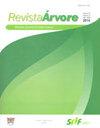DEGREE OF INFESTATION AND PREFERENCES OF HEMIPARASITES IN URBAN ARBORIZATION
IF 0.8
4区 农林科学
Q4 FORESTRY
引用次数: 0
Abstract
ABSTRACT Mistletoe is an important nutritional resource for the frugivorous ornithological fauna in several ecosystems. However, in great intensity, they can reduce the vigor of their host trees, requiring adequate management in urban afforestation, without depleting this source of food for birds. The hypothesis that there are hemiparasites with host specificity was the reason for this study. Thus, a floristic census of the trees was carried out at UFMT, campus Cuiabá; the infestation by genus of hemiparasite present was recorded, in quantity and degree of infestation, in addition to the quantification of seeds of the hemiparasite germinated without the development of the vegetative part, whose cotyledons necrotized and died. A total of 4265 tree individuals were evaluated, distributed in 46 families, in which 16,52% were identified of the genera Phoradendron, Psittacanthus, and Struthanthus, of which about 90,0% were Psittacanthus. The highest infestation occurred in 24 families, highlighting Fabaceae (28,3%) and Combretaceae (25,6%), and the species Terminalia catappa, Anadenanthera peregrina, and Vatairea macrocarpa. The presence of germinated seeds of the hemiparasite with dead cotyledons varies between tree species and between individuals of the same species. The highlight was in Rutaceae, Arecaceae, and Rubiaceae, and in the species Acrocomia aculeata, Caryocar villosum, and Genipa americana L. that present individuals with natural control potential, even with the presence of frugivorous ornithological fauna and the dispersion of the hemiparasite. In general, the intensity and degree of infestation are low, and there is no infestation in the Caryocaceae, Rutaceae, and Rubiaceae families, highlighting the species Caryocar villosum, Murraya paniculata and Alibertia edulis.城市绿化中半寄生虫的侵害程度及偏好
槲寄生是许多生态系统中食性鸟类动物群的重要营养来源。然而,在强度很大的情况下,它们会降低寄主树木的活力,这需要在城市造林中进行适当的管理,而不会耗尽鸟类的食物来源。假设存在具有宿主特异性的半寄生虫是本研究的原因。因此,在福建农林大学,校园cuiab进行了树木的植物区系普查;记录了各属半寄生虫侵染的数量和程度,并定量了半寄生虫种子萌发时营养部分未发育,子叶坏死死亡的情况。共鉴定树株4265株,分布于46科,其中Phoradendron、Psittacanthus和Struthanthus属占16.52%,其中Psittacanthus属占90.5%。侵染率最高的有24科,以豆科(28.3%)、combretacae科(25.6%)、Terminalia catappa、Anadenanthera peregrina和Vatairea macrocarpa居多。带有死亡子叶的半寄生虫的发芽种子在不同树种和同一树种的个体之间存在差异。重点是芦花科、槟榔科和芦花科,以及Acrocomia acleata、Caryocar villosum和Genipa americana L.,这些物种具有自然控制潜力,即使存在食果鸟类动物群和半寄生虫的分散。总体而言,侵害强度和程度较低,石竹科、芦笋科和茜草科均未发生侵害,以石竹科(Caryocar villosum)、paniculata和Alibertia edulis较为突出。
本文章由计算机程序翻译,如有差异,请以英文原文为准。
求助全文
约1分钟内获得全文
求助全文
来源期刊

Revista Arvore
FORESTRY-
CiteScore
1.00
自引率
0.00%
发文量
32
审稿时长
4-8 weeks
期刊介绍:
A Revista Árvore é um veículo de comunicação científica da Sociedade de Investigações Florestais – SIF. O jornal é de acesso gratuito, revisado por pares, que publica bimestralmente trabalhos científicos originais no campo da Ciência Florestal. As áreas temáticas para publicação são: Ambiência e Conservação da Natureza, Manejo Florestal, Silvicultura e Tecnologia da Madeira e Utilização de Produtos Florestais.
A política editorial visa manter alta conduta ética em relação à publicação e aos seus funcionários, rigor na qualidade dos artigos científicos, seleção de revisores qualificados, respeito profissional aos autores e processo de tomada de decisão imparcial. A Revista Árvore publica artigos apenas em inglês.
Artigos de revisão podem ser publicados se houver uma discussão relevante resumindo o estado da arte sobre o assunto. A revisão estrita da literatura não é aceita.
 求助内容:
求助内容: 应助结果提醒方式:
应助结果提醒方式:


